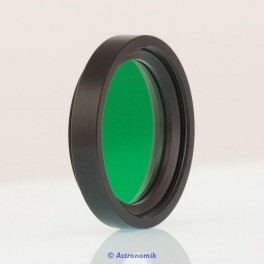 Ingrandisci
Ingrandisci Filtro Astronomik ASO3 filetto T2
Astronomik
- Rimuovi questo prodotto dai miei preferiti
- Aggiungi questo prodotto ai miei preferiti.
- Stampa
Astronomik ASO3 - OIII Filter 12 nm - T2 mount (M42x0.75mm)
 Ingrandisci
Ingrandisci Astronomik ASO3 - OIII Filter 12 nm - T2 mount (M42x0.75mm)
Codice articolo: 8H00BJ
![Astronomik ASO3 - OIII Filter 12 nm - T2 mount (M42x0.75mm) [EN] Astronomik ASO3 - OIII Filter 12 nm - T2 mount (M42x0.75mm) [EN]](https://www.teleskop-express.it/img/cms/astronomik-o3-t2.jpg) From the start, the Astronomik OIII filter has been very specifically designed for the visual observation of gaseous and planetary nebulae. The extremely narrow pass band of the two [O III] lines brings a substantial contrast gain to these lines even under best observation conditions. On faint supernova remnants and faint planetary nebulae, the Astronomik [O III] filter will often make the difference as to whether the object can be seen or not!
From the start, the Astronomik OIII filter has been very specifically designed for the visual observation of gaseous and planetary nebulae. The extremely narrow pass band of the two [O III] lines brings a substantial contrast gain to these lines even under best observation conditions. On faint supernova remnants and faint planetary nebulae, the Astronomik [O III] filter will often make the difference as to whether the object can be seen or not!The optimal aperture ratio for the use of the filter is 1:3 to 1:15 with apertures of more than 6" (150 mm). Transmission losses and chromatic distortions, which arise with other filters, occur with Astronomik OIII filters only when extremely bright aperture ratios of 1:3 and more come into play. The Astronomik O-III filters thus can expand the view of dispersed objects, generally speaking, to the whole visual field of view of the eyepiece and are not limited to only the center of the eyepiece.
Main use:
Since enough light must be available to make use of the [O III] filter it is best to use this filter with apertures of more than 6" (150 mm). Smaller instruments do not gather enough light for meaningful and satisfying astronomical work when using medium magnification. However, please note: Many experienced Deep Sky observers, with apertures of more than 10" (250 mm), prefer using the OIII filter instead of the more versatile UHC filter. Due to the high optical quality of the Astronomik [O III] filter substrate, you will see the same needle-sharp stars as you would from your regular telescope. With small apertures, using low power is necessary for visual work. In this case, the telescope can still give nice views.
Astrophotography:
You also can use the filter for astrophotography with high sensitive CCD sensors. The filter allows long exposure times, but you need an additional IR-blocking filter if using refractive optics.
Suitability:
♦ Visual observation (dark skies): Very good, huge contrast enhancement at [O III] emission nebulas
♦ Visual observation (urban skies): Very good, huge contrast enhancement at [O III] emission nebulas
♦ Film photography: It depends, very long exposure time
♦ CCD photography: Good, when used with an additional IR-block-filter
♦ DSLR photography (original): Very good, huge contrast enhancement at [O III] emission nebulas
♦ DSLR photography (astro modified): Very good, huge contrast enhancement at [O III] emission nebulas
♦ DSLR photography (MC modified): Good, when used with an additional IR-blocking filter
♦ Webcam / Video (Planets): Unsuitable
♦ Webcam / Video (Deep Sky): Reasonable, if light pollution is a big problem and [O III] objects are being observed
Technical Data:
♦ Transmission of nearly 100% of both [O III] lines
♦ Complete blocking of all disturbing wavelength coverages
♦ The ideal filter for telescopes 10" (25 cm) and larger
♦ Main operational use: Planetary nebulae & super nova remnants
♦ No moisture-sensitivity, no aging, and totally scratch-proof
♦ Excellent carrier material - substrate is optically polished. The optical performance (resolution & contrast) of your telescope is not reduced in any way by the filter.
♦ Parfocal with other Astronomik filters
♦ Glass thickness: 1 mm
♦ Completely resistant against high humidity, scratches and aging effects
♦ Diffraction limited, the filter will not reduce the optical performance of your telescope!
♦ Astronomik filters are delivered in a high-quality, long lasting, filter box
Transmission curve:
![Astronomik ASO3 - OIII Filter 12 nm - T2 mount (M42x0.75mm) [EN] Astronomik ASO3 - OIII Filter 12 nm - T2 mount (M42x0.75mm) [EN]](https://www.teleskop-express.it/img/cms/astronomik-o3-kurve.jpg)
♦ The horizontal axis is the wavelength in nanometers (nm). 400 nm is deep blue, at 520 nm the human eye senses green and at 600 nm red. At 656 nm is the famous "H-Alpha" emission line of hydrogen.
♦ The transmission in % is plotted on the vertical axis.
♦ The red line shows the transmission of the filter.
♦ Visual filters: The grey line in the background shows the relative sensitivity of the human eye at night. The maximum is at ~510 nm and drops to longer and shorter wavelengths. You can easily see, that you can´t see anything of the H-alpha line at night (even if you can during daylight!) The sensitivity at 656 nm is 0% at night!
♦ Photographic filters: The grey line in the background shows the sensitivity of a typical CCD sensor.
♦ The most important artifical emission lines are shown in orange. The artifical light pollution is dominated by see mercury (Hg) and sodium (Na), which are used in nearly all streetlights.
♦ The most important emission lines from nebulas are shown in green. The most important lines are from ionized hydrogen (H-alpha and H-beta) and double ionized oyxgen ([O III]). The square brackets indicate that these lines are forbidden.
